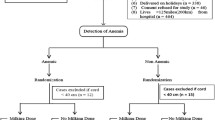Abstract
Objective
To investigate the effect of umbilical cord milking on hematological parameters at 6 weeks of age in late preterm neonates.
Design
Randomized controlled trial.
Setting
A tertiary care center of Northern India during 2013-14.
Participants
200 moderate to late preterm neonates randomly allocated to early cord clamping or umbilical cord milking group (100 in each).
Intervention
In milking group, 25 cm length of cord was milked towards the baby thrice after separating (within 30 s) it from placenta.
Main outcome measures
Hemoglobin and serum ferritin at 6 weeks of age.
Results
Mean (SD) serum ferritin [428.9 (217.6) vs. 237.5 (118.6) ng/mL; P< 0.01] and hemoglobin [12.1 (1.5) vs. 10.4 (1.2) gm/dL; P<0.01] at 6 weeks were significantly higher in umbilical cord milking group. In early neonatal period, hemodynamic and hematological parameters were not significantly different. Higher incidence of jaundice with higher phototherapy rates (33% vs. 9%; P<0.01) were noted in umbilical cord milking group.
Conclusion
In preterm neonates, umbilical cord milking at birth enhances iron stores at 6 weeks of age. Higher phototherapy rates with this intervention are a matter of concern.
Similar content being viewed by others
References
Gupta R, Ramji S. Effect of delayed cord clamping on iron stores in infants born to anemic mothers: A randomized controlled trial. Indian Pediatr. 2002;39:130–5.
Mathew JL. Timing of umbilical cord clamping in term and preterm deliveries and infant and maternal outcomes: A systematic review of randomized controlled trials. Indian Pediatr. 2011;48:123–9.
Mercer JS, Erickson-Owens DA. Is it time to rethink cord management when resuscitation is needed? J Midwifery Womens Health. 2014;59:635–44.
Katheria A, Blank D, Rich W, Finer N. Umbilical cord milking improves transition in premature infants at birth. PloS. One. 2014; 9:e94085.
Upadhyay A, Gothwal S, Parihar R, Garg A, Gupta A, Chawla D, et al. Effect of umbilical cord milking in term and near term infants: randomized control trial. Am J Obstet Gynecol. 2013; 208:120. e1–6.
Taylor V. (for Prof. William Tarnow-Mordi). Correct umbilical cord “milking” technique. Australian Placental Transfusion Study, West Mead Hospital. Sydney, Australia. Available from: http://www.videos.med.usyd.edu.tau/unitube/videos/file19. Accessed May 15, 201.
Van Rheenen P, de Moor L, Eschbach S, de Grooth H, Brabin B. Delayed cord clamping and haemoglobin levels in infancy: A randomised controlled trial in term babies. Trop Med Int Health. 2007;12:603–16.
Rabe H, Jewison A, Alvarez RF, Crook D, Stilton D, Bradley R, et al. Milking compared with delayed cord clamping to increase placental transfusion in preterm neonates: a randomized controlled trial. Obstet Gynecol. 2011;117:205–11.
Grajeda R, Pé rez-Escamilla R, Dewey KG. Delayed clamping of the umbilical cord improves hematologic status of Guatemalan infants at 2 month of age. Am J Clin Nutr. 1997;65:425–31.
Lanzkowsky P. Effects of early and late clamping of umbilical cord on infant’s haemoglobin level. BMJ. 1960;2:1777–82.
Chaparro CM. Timing of umbilical cord clamping: Effect on iron endowment of the newborn and later iron status. Nutr Rev. 2011;69:S06–6.
McDonald SJ, Middleton P. Effect of timing of umbilical cord clamping of term infants on maternal and neonatal outcomes. Cochrane Database Syst Rev. 2008; CD004074.
Hosono S, Mugishima H, Fujita H, Hosono A, Minato M, Okada T, et al. Umbilical cord milking reduces the need for red cell transfusions and improves neonatal adaptation in infants born at less than 29 weeks’ gestation: A randomised controlled trial. Arch Dis Child Fetal Neonatal Ed. 2008; 93:F14–9.
Erickson-Owens DA, Mercer JS, Oh W. Umbilical cord milking in term infants delivered by cesarean section: a randomized controlled trial. J Perinatol. 2012;32:580–4.
Nakagawa M, Ishida Y, Nagaoki Y, Ohta H, Shimabukuro R, Hirata M, et al. Correlation between umbilical cord hemoglobin values and rates of jaundice requiring phototherapy in healthy newborns. Pediatr Int. 2014 De. 23.[Epub ahead of print].
Ranjit T, Nesargi S, Rao PN, Sahoo JP, Ashok C, Chandrakala BS, et al. Effect of early versus delayed cord clamping on hematological status of preterm infants at 6 wk of age. Indian J Pediatr. 2015;82:29–34.
Jaiswal P, Upadhyay A, Gothwal S, Singh D, Dubey K, Garg A, et al. Comparison of two types of intervention to enhance placental redistribution in term infants: Randomized control trial. Eur J Pediatr. 2015 Mar 24. [Epub ahead of print].
Author information
Authors and Affiliations
Corresponding author
Rights and permissions
About this article
Cite this article
Kumar, B., Upadhyay, A., Gothwal, S. et al. Umbilical cord milking and hematological parameters in moderate to late preterm neonates: A randomized controlled trial . Indian Pediatr 52, 753–757 (2015). https://doi.org/10.1007/s13312-015-0711-1
Received:
Revised:
Accepted:
Published:
Issue Date:
DOI: https://doi.org/10.1007/s13312-015-0711-1




